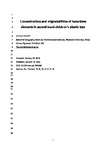Concentrations and Migratabilities of Hazardous Elements in Second-Hand Children's Plastic toys.
| dc.contributor.author | Turner, Andrew | |
| dc.date.accessioned | 2018-03-27T13:07:58Z | |
| dc.date.issued | 2018-03-06 | |
| dc.identifier.issn | 0013-936X | |
| dc.identifier.issn | 1520-5851 | |
| dc.identifier.uri | http://hdl.handle.net/10026.1/11188 | |
| dc.description.abstract |
About 200 second-hand plastic toys sourced in the UK have been analyzed by X-ray fluorescence spectrometry for hazardous elements (As, Ba, Cd, Cr, Hg, Pb, Sb, Se) and Br as a proxy for brominated flame retardants. Each element was detected in >20 toys or components thereof with the exception of As, Hg, and Se, with the frequent occurrence of Br, Cd, and Pb and at maximum concentrations of about 16000, 20000, and 5000 μg g-1, respectively, of greatest concern from a potential exposure perspective. Migration was evaluated on components of 26 toys under simulated stomach conditions (0.07 M HCl) with subsequent analysis by inductively coupled plasma spectrometry. In eight cases, Cd or Pb exceeded their migration limits as stipulated by the current EU Toy Safety Directive (17 and 23 μg g-1, respectively), with Cd released from yellow and red Lego bricks exceeding its limit by 1 order of magnitude. Two further cases were potentially noncompliant based on migratable Cr, with one item also containing >250 μg g-1migratable Br. While there is no retroactive regulation on second-hand toys, consumers should be aware that old, mouthable, plastic items may present a source of hazardous element exposure to infants. | |
| dc.format.extent | 3110-3116 | |
| dc.format.medium | Print-Electronic | |
| dc.language | en | |
| dc.language.iso | en | |
| dc.publisher | American Chemical Society | |
| dc.subject | Child | |
| dc.subject | Flame Retardants | |
| dc.subject | Humans | |
| dc.subject | Infant | |
| dc.subject | Mercury | |
| dc.subject | Plastics | |
| dc.subject | Play and Playthings | |
| dc.subject | Spectrometry, X-Ray Emission | |
| dc.title | Concentrations and Migratabilities of Hazardous Elements in Second-Hand Children's Plastic toys. | |
| dc.type | journal-article | |
| dc.type | Journal Article | |
| plymouth.author-url | https://www.ncbi.nlm.nih.gov/pubmed/29350926 | |
| plymouth.issue | 5 | |
| plymouth.volume | 52 | |
| plymouth.publication-status | Published | |
| plymouth.journal | Environmental Science and Technology | |
| dc.identifier.doi | 10.1021/acs.est.7b04685 | |
| plymouth.organisational-group | /Plymouth | |
| plymouth.organisational-group | /Plymouth/Faculty of Science and Engineering | |
| plymouth.organisational-group | /Plymouth/Faculty of Science and Engineering/School of Geography, Earth and Environmental Sciences | |
| plymouth.organisational-group | /Plymouth/REF 2021 Researchers by UoA | |
| plymouth.organisational-group | /Plymouth/REF 2021 Researchers by UoA/UoA07 Earth Systems and Environmental Sciences | |
| plymouth.organisational-group | /Plymouth/Research Groups | |
| plymouth.organisational-group | /Plymouth/Research Groups/BEACh | |
| plymouth.organisational-group | /Plymouth/Research Groups/Marine Institute | |
| plymouth.organisational-group | /Plymouth/Users by role | |
| plymouth.organisational-group | /Plymouth/Users by role/Academics | |
| dc.publisher.place | United States | |
| dcterms.dateAccepted | 2018-01-19 | |
| dc.rights.embargodate | 2019-1-19 | |
| dc.identifier.eissn | 1520-5851 | |
| dc.rights.embargoperiod | 12 months | |
| rioxxterms.versionofrecord | 10.1021/acs.est.7b04685 | |
| rioxxterms.licenseref.uri | http://www.rioxx.net/licenses/under-embargo-all-rights-reserved | |
| rioxxterms.licenseref.startdate | 2018-03-06 | |
| rioxxterms.type | Journal Article/Review |


